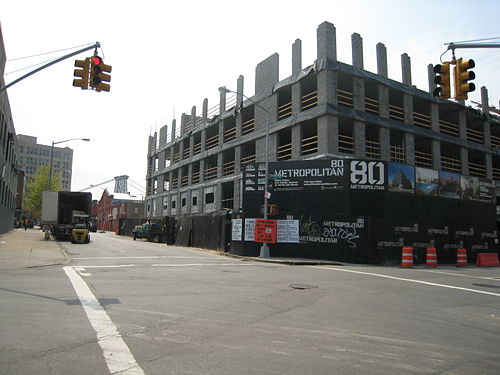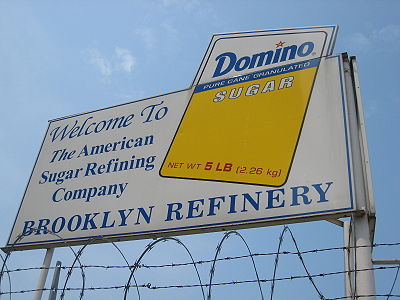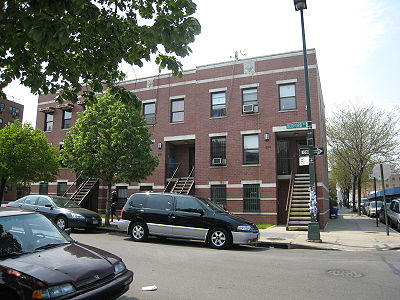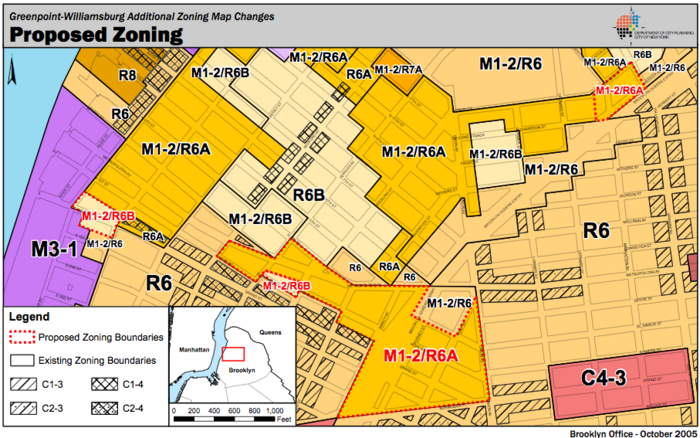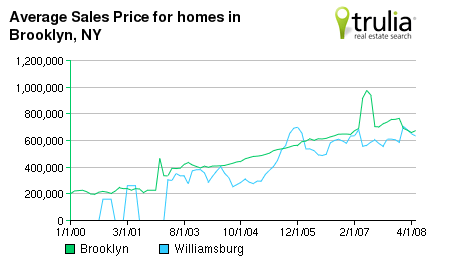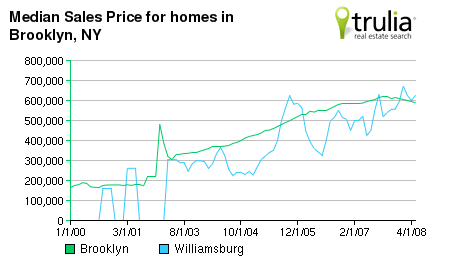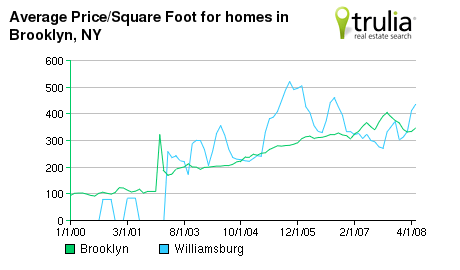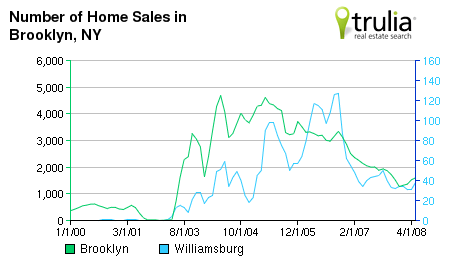From The Peopling of New York City
Contents |
Overview
From the mid-1930s to the 1960s, public housing projects started to replace thousands of old, decaying buildings. In 1957, construction of the Brooklyn-Queens Expressway cut through Williamsburg, destroying many low-income, single- and two-family homes.
In South Williamsburg, the Hasidic community continued to grow, and the Hispanics were crowded into archaic tenements. Friction increased between the Hispanics and the Jews as they fought over government money and housing.
During the past twenty years, Williamsburg has become home to a new group, the bohemians. In the Northside, artists discovered the low rents of large lofts (converted from former factories). Recently, real estate has been booming in the area. Abandoned factories are now being converted to expensive condos and apartments. Construction of high-rise buildings is changing the face of the neighborhood.
Although there is growing concern among residents that their old neighborhood is disappearing, positive change is on the way. The waterfront, fallen into neglect, will soon be revitalized. With both community and city support, there is opposition to additional power plants and solid waste companies. In May 2005, New York City government approved zoning changes that would allow for open spaces, parks, affordable housing and some industry.[1]
Shutdown of the Domino Sugar Refinery
End of an Era
The Domino Sugar refinery in Williamsburg was bought in 2004, ending a chapter of Brooklyn's industrial waterfront history. C.P.C. (Community Preservation Corporation) Resources, and Isaac Katan, a Brooklyn developer who helped gentrify Fourth Avenue in Park Slope, bought the land and the buildings of the rundown plant. The developers wouldn’t say how much they paid for the property or what was on the future agenda, but released a statement stating they "look forward to working with the community and the city as [they] develop [their] plans for the site."
History
The Domino plant, with its distinctive sign hovering over the East River, just north of the Williamsburg Bridge, had been operating since the 1880s and was acquired in 2001 by American Sugar Refining. American Sugar still has plants in Yonkers, Baltimore and Chalmette, La., but the Brooklyn refinery, once the world's largest, had apparently been the most inefficient, with about only 25 remaining employees.
Future?
Joseph Markowitz, who had bought the company's office building and parking garage across the street, said he would hope it gets rezoned for residential use, a goal he set for his own property. But City Planning Department officials, who at the time were pushing forward with their proposal to rezone the Williamsburg and Greenpoint waterfront to encourage residential and recreational uses, had other thoughts. They had drawn their plan to preserve the Domino site for manufacturing, receiving approval by several officials and labor advocates who would like to see Brooklyn's industrial legacy preserved.[2]
The Greenpoint-Williamsburg Plan
Development of new housing, including units affordable to low- to middle-income households, is an important element of the Greenpoint-Williamsburg Land Use and Waterfront Plan.
Under Mayor Bloomberg's New Housing Marketplace plan, the City's Department of Housing Preservation and Development (HPD) and Housing Development Corporation (HDC) have designed programs to face the challenges of current affordable housing development, such as building affordable units on privately owned sites and former industrial land. The City is also said to be “committed to investments in affordable housing within areas undergoing rezoning to facilitate new housing development, such as Greenpoint-Williamsburg.”
HPD has analyzed programs on both upland and waterfront sites, determining whether these programs are financially feasible and offer developers advantages.[3]
Feedback from a Native
In an interview with Williamsburg resident Kenneth Leong, 19, we find out how the natives feel about the recent real estate changes.
Where in Williamsburg do you live exactly, and how long?
South 2nd between Driggs and Bedford. I use to live at Lorimer, which is about 5 minutes away from Bedford. But about 19 years.
Oh wow, that's long and when did you move to the north side?
Well about a few months ago in June.
As a Williamsburg resident what are your views on the recent real estate development in the area?
Well there's a dramatic increase in housing development. Many new condos are being built. Also, the White people. It use to be predominately Puerto Rican and Black, but now that has decreased.
In the North?
Yea, around here especially on the Bedford side. It's beginning to transition to a smaller scale of Manhattan.
And as a native how do you feel about that? Good or bad for the neighborhood?
Its good for development but real estate cost is going up and the public transportation is a hassle. The L train is always packed in the mornings and sometimes you even have to wait for a few trains because it's so packed.
Are other residents complaining? And is it like a major local problem?
I don't know about that but you can see that current residents are being pushed out and more people are coming in.
From Manhattan?
Yea. Compared to Manhattan, real estate here is cheap. But compared to other parts of Brooklyn or 5 years ago, real estate was much cheaper than today.
The residents being pushed out, who are they and where are they moving?
I'm not sure where they go to, but they are mostly Hispanics and a few Blacks.
Real Estate Market Trends
The following graphs were found under the Williamsburg, Brooklyn real estate guide on Trulia.com. [4]
References
- ↑ "Our Brooklyn-Williamsburg History." 2005. Brooklyn Public Library. <http://www.brooklynpubliclibrary.org/ourbrooklyn/williamsburg/>.
- ↑ Cardwell, Diane, and Rosalie R. Radomsky. "Developers Known for Residential Work Buy Domino Sugar Plant on Brooklyn Waterfront." The New York Times 1 July 2004. <http://www.nytimes.com/2004/07/01/nyregion/01sugar.html?ex=1210651200&en=b360413f3a4b59f9&ei=5070>.
- ↑ New York City. NYC Department of City Planning. Greenpoint-Williamsburg. <http://www.nyc.gov/html/dcp/html/greenpointwill/greenaffordhouse.shtml>.
- ↑ http://www.trulia.com/real_estate/Williamsburg-Brooklyn/5274/

